Brand Voice: 7 Top Things to Consider in Brand Building
Do you recall the famous Coca-Cola tagline, ‘Taste the Feeling,’ or any of their other iconic taglines? What’s the immediate impression that comes to mind when you read them? Perhaps it evokes a sense of friendliness, a lighthearted atmosphere, social connections, or, most importantly, a warm welcome. This is precisely what a brand voice accomplishes through taglines, copy, blogs, and a company’s mission statement.
In simple terms, a brand voice is the initial and unique identity of your organization. It’s as essential for a brand as individuality is for humans. It not only defines an identity but also sets you apart from competitors and instills emotions in customers, resonating with them every time they encounter your brand.
Learn what a brand voice is and explore the factors you must consider when building your brand.
What is Brand Voice
Remember Puma’s Fearless Campaign from 2022, which was set for the FIFA World Cup? What exactly did that campaign evoke? Using their brand and the event as leverage, they successfully conveyed a message of sportiness and fearlessness.
That’s the voice of the brand, which serves as the foundational representation of your brand, a constant presence that endures throughout your branding and communication journey. It defines the approach you take in engaging with your customers through your content and copy, thereby becoming the central identity of your brand.
Therefore, brand voice is crucial and often treated as a guideline for businesses on how they should connect with their audience. Given its profound and enduring nature, it forms the bedrock of your brand identity and isn’t subject to frequent changes.
A distinct and unique brand tone of voice is highly important (84%) and most marketers believe they have achieved this (77%).
Importance of Brand Voice
How do you feel when you hear that friendly ‘Hello, Moto’ from Motorola? It’s amazing how a brand voice can make you instantly think of a brand, right?
A clear voice of the brand provides a strong identity for your brand and stamps a unique footprint that helps people remember your brand.
Let’s discuss some key factors about it.
1. Forms brand identity and recognition
A unique voice gives your brand a significant identity and recognition on different platforms, which boosts presence and awareness.
2. Brings a USP
Not only do your products and services bring out the USP for your brand, but a brand voice too. A consistent tone of voice helps to locate the USP and encourages the same to rise.
3. Establishes real-time connections
Words play a vital role in building relationships and so the voice strengthens them. A relevant voice of the brand that resonates with your audience will bring real-time connections.
4. Helps in professional branding and communication
A strong voice of the brand initiates professional branding and leads communication in many ways. Whether it is corporate communication or marketing communication, an aligned brand voice will always help you with your brand building.
5. Stand out from the crowd
Your unique voice of the brand in the market gives you leverage to stand out from the crowd and become stronger than your competitors.
Also Read: 7 Brands That Nailed It On Single’s Day
In Headstream’s research, a captivating brand story can boost future product purchases by 55%, inspire 44% to share the story, and prompt 15% to make an immediate purchase.
Components of Brand Voice
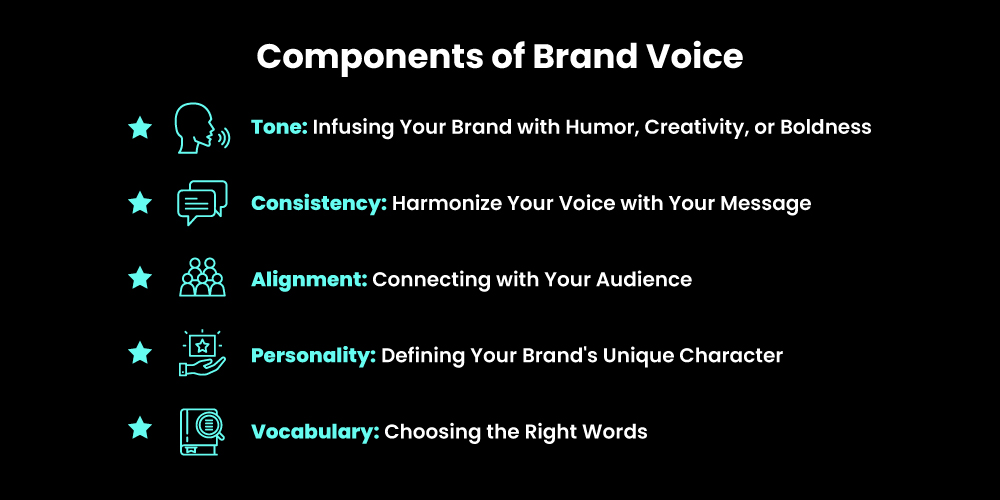
Have you ever noticed how the color schemes used in branding, like McDonald’s bright red and yellow, can instantly convey a brand’s personality and influence your perception of it?
Likewise, whatever niche your brand comes from, there has to be one voice that truly resonates with your audience at every level. To form the one, you need to know first what exactly you need to put into making a serious formation.
1. Tone and style
Brand tone of voice sets the brand personality and gives a familiar presence, every time your brand comes into the picture. The tone and style are an intangible essence that connects your brand with the audience.
2. Messaging consistency
Creating a brand tone and voice goes hand in hand with maintaining messaging consistency, ensuring that the information you convey aligns seamlessly with your established brand voice.
3. Audience alignment
Your chosen brand voice and tone should resonate with your target audience. If your audience primarily consists of elite-class individuals, it’s essential to incorporate nuances that enable them to connect with your brand.
4. Brand Personality
It is often understood as brand personality, which is right to some extent. As the voice of the brand acts as a reflection of your brand’s personality, it’s crucial to tailor it to align with your brand persona.
5. Vocabulary and language
Whether it’s a creative, simple, technical, or humorous approach, the elements you select for your brand voice essentially become the face of your brand.
Therefore, it’s imperative to choose wisely, as it shapes how your brand is perceived.
In a study conducted by Cognizant 86 % of respondents agree that developing a brand’s voice personality is extremely important.
Brand Voice vs Brand Tone
The recent, 2023 Holiday Campaign, “Bunny Saves Christmas,” by Duracell has been a real crowd-pleaser, drawing loads of attention thanks to their playful and creative brand voice. Duracell chose a lighthearted and humorous tone that perfectly matches their brand’s personality, and it has everyone talking! Their clever use of witty and emotional buzz for retargeting and awareness has struck a chord with the audience.
As a brand owner, understanding the subtle nuances between the tone and voice of your brand is key to delivering a crystal-clear message. It’s like knowing the secret sauce that makes your brand uniquely awesome! And there you have it……
Brand voice: It is the consistent element of your brand that will not change seasonally and always be the same across all the platforms. It is a constant identity that lays the foundation, and company’s goals and works on consistency.
Brand tone: Brand tone is the tonality of the voice. It can be funny, romantic, cheerful, or innovative. Unlike brand voice, brand tone can be changed as per relevance such as moment marketing, festive seasons, or any big event.
The point here is not to get confused about what exactly are both and how they work. But to understand that both of them are the pillars of making the brand stand out from the crowd.
Also Read: Brand Identity vs Brand Image
In a survey conducted by Marq, formerly known as Lucidpress, 85% of organizations claimed to possess brand guidelines, but merely 30% acknowledged consistent enforcement. Consequently, a significant 77% of brands experience the issue of off-brand content.
How to Set the Brand Voice and Tone for Your Business
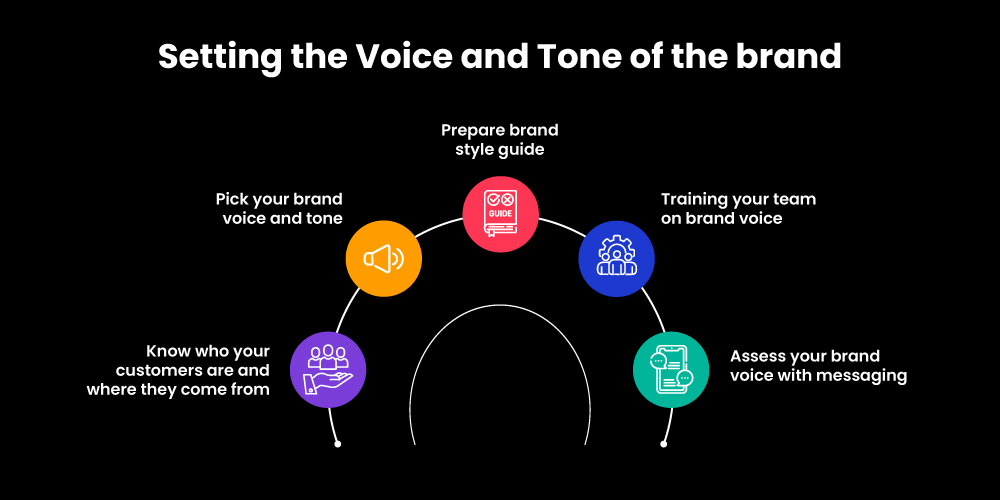
Have you ever wondered how to establish the right brand voice and tone for your business, and what kind of impact it can have on the way your customers connect with your brand?
Cadbury Worldwide Hide Campaign (2023) has shown how you as a brand owner can stimulate a powerful message while sticking to your brand voice or may create one through strong objectives. The idea of hiding digital purple eggs for your loved ones via Google Street View is just as lovely while setting a message that embodies a special connection.
Likewise, setting brand voice and tone is as important as designing your brand logo and name. It’s like crafting the personality and character of your brand, making it relatable and memorable for your customers.
1. Identifying your target audience
Analyze the demographics of your target audience and tailor your message accordingly. Make sure the voice of the brand is consistent across all channels. Test and refine the voice of the brand to ensure it is effective.
2. Defining your brand’s personality
Your brand’s voice should always align with your brand’s personality. If your brand offers a straightforward and clear voice, similar to Apple Products and Services, it should be reflected in the brand’s voice as well.
3. Selecting the right tone and style
While the voice of the brand elements serve as the permanent framework for your business, the tone and style may vary based on objectives and goals. Remember that the voice of the brand should align with the intended tone and style.
4. Developing brand guidelines
Customize the brand guidelines following your company’s mission and vision. Incorporate essential factors and integrate the company’s values and long-term goals into the guidelines.
5. Brief your writing and executing team on brand voice
Ensure that your writing and execution team is well-informed about all the important factors you intend to implement and reflect in your brand voice. As a brand owner or manager, share the voice of the brand objectives with your team to create the right message.
6. Monitoring and adapting your voice as needed
Once everything is in place, consistently monitor your work and the audience’s responses. Keep an eye on social media trends and other activities on your platforms to gauge how your brand is being perceived.
There is a very high level of agreement that brand language is important to business success (90%) and that brand language is a core part of marketing strategy (91%).
7 Top Things to Consider in Brand Building ( Brand Voice)
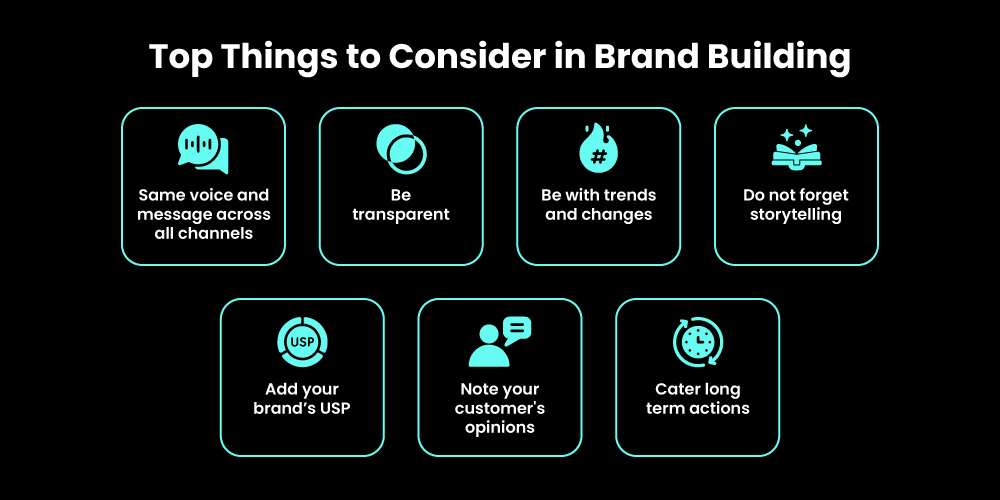
Have you considered how honing your brand voice can be one of the top tips for successful brand building? To build a brand that truly connects, you must first understand your audience. Who are they? What do they value?
Take, for example, Nike’s “Dream Crazier” campaign from 2019. By tapping into the emotions and aspirations of female athletes, Nike not only knew their audience but also empowered them, establishing a connection that went beyond mere product promotion.
1. Brand consistency across channels
The voice of your brand should be well aligned with your brand objectives and the same across all channels. The method of presenting your brand may vary depending on channel requirements, but the voice of your brand should always match.
2. Authenticity and transparency
Maintain transparency and authenticity in your brand voice. For instance, if your business offers hair extensions and your tagline is ‘Organic and Natural,’ ensure it genuinely aligns with the product and the voice you aim to establish with your customers.
3. Adapting to market changes
The brand voice should be revised as per significant market changes and trends. As per today’s scenario, Gen-Z lingo, memes culture, and slang are widely acceptable and known. But that does not mean, you should incorporate them all, just be with trends and market changes to not lose the grip.
4. Storytelling and emotional engagement
As you embark on the journey of establishing your brand through the development of your brand voice, consider the importance of storytelling and emotional engagement. Your brand’s voice serves as the storyteller of your brand, creating emotional connections that foster stronger relationships with your customers.
5. Unique value proposition
Your brand USP should reflect in your voice of brand for strong brand building. Every word that encompasses the brand voice should relate to your brand positioning and strength.
6. Customer feedback and adaptation
Give significant attention to customer feedback when it comes to shaping your voice of the brand. Taking customer input seriously is a crucial step in making your brand stand out and creating content that resonates with your audience.
7. Long-term sustainability
Focus on a long-term plan and make sure your brand voice and tone reflect it. When you incorporate your vision and future goals, it helps your audience understand what your brand stands for. Take McDonald’s, for example. Their tagline, ‘I’m loving it,’ not only tells people they enjoy their food but also conveys a sense of care, friendliness, and a passion for good food. This tagline aligns with their long-term plan to keep providing tasty meals and growing their brand.
In a report by Renderforest, 54% of businesses agree that brand consistency contributes to the growth of their business.
Some Famous Examples of Understanding Brand Voice
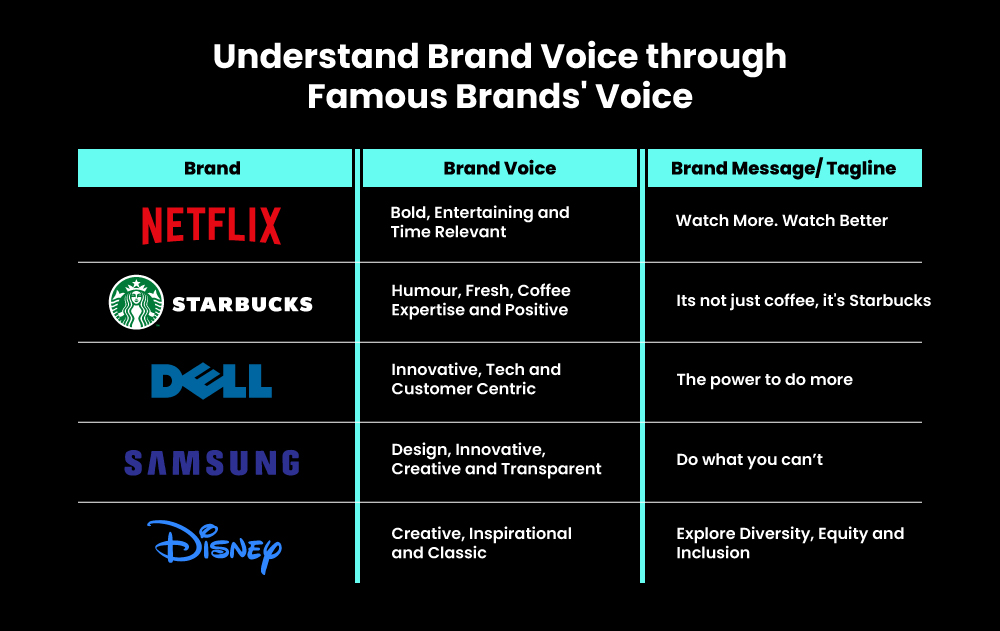
How do companies like Netflix and Starbucks use their unique ways of communicating to build strong brands? It’s interesting how their brand voices set them apart from their competitors and create a distinctive identity that consumers can easily recognize and connect with.
1. Netflix
Netflix has always been into mastering trends and keeping its voice fresh and loud. In each geographical area, they may have different languages or preferences. However, they have maintained the fun, entertaining, and exclusive voice of the brand on all their platforms.
2. Starbucks

Starbucks’s brand voice strategy focuses on community building, social message, humor, and coffee expertise. They use a conversational tone and focus on storytelling, with a real human touch. They also use puns and witty phrases, to create a light-hearted and positive atmosphere.
3. Dell
Being a tech brand, Dell has marked its position as a strong solution provider in the technology space. Their brand’s voice also reflects the same and offers business-centric, straightforward messages, and tech-related messages. Their recent tagline” Powering the Possible” is a great example of an innovative brand voice.
4. Samsung
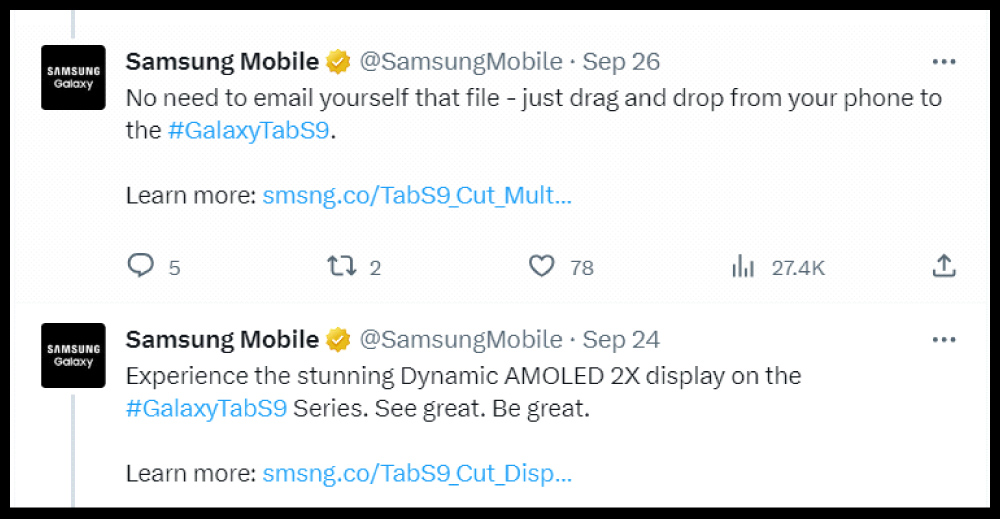
Throughout the history of Samsung, they have made an effort to be transparent and direct with their audience when it comes to the messages they serve them. They have always placed a high priority on design, innovation, inspiration, and modernity.
5. Disney
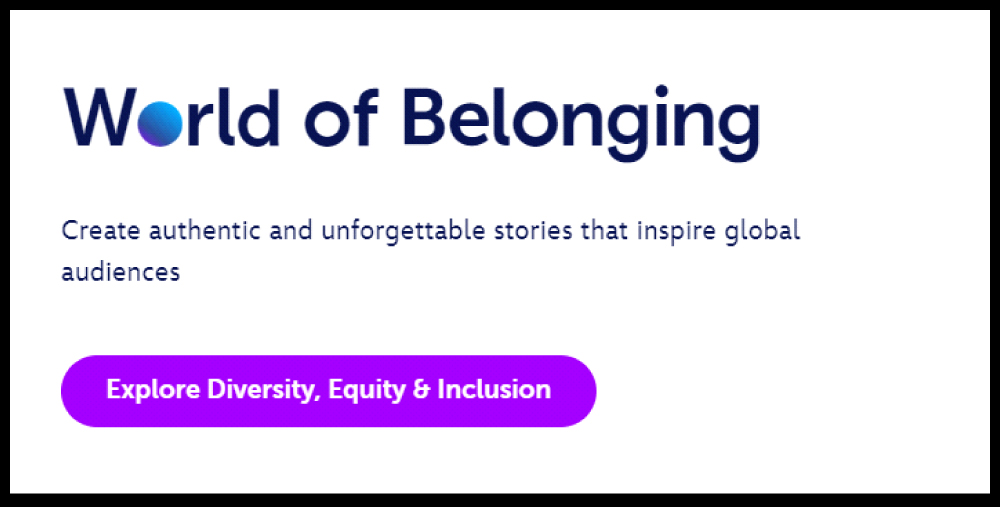
Disney being more than 99 years old, also follows a specific brand voice which gives them identity and makes them different from others. Creativity, Imagination, Timeless, Fun, and Storytelling are some of the factors that they keep repeating in their brand voice to connect with their audience.
Also Read: Brand Taglines
Mastroke: Brand Voice
At Mastroke, a Creative and Marketing Agency offering a wide range of Digital Marketing Services for all types of businesses, we embrace “The Mastroke Mindset.” This belief has inspired the development of our brand voice, characterized by professionalism, creativity, transparency, and motivation.
Know some additional tips on brand voice
- Do not use harsh, sensitive, and unorganized tones in your brand voice
- Follow the consistency with your brand messaging
- Make sure you are not over-promising or exaggerating your message
- Research, research, and research! See your competitor, trends and internal factors to asses your brand voice
- Do not copy blindly! It’s a long race so make sure you draw every line strategically
Conclusion
As a result, successful branding requires a well-defined and consistent brand voice. Not only does it help set a brand apart, but it also fosters relationships, trust, and recognition. The brand voice is more than words; it represents the personality and heart of the brand, and it should be nurtured, adjusted, and cared for at every stage of its development.
Find more to know about branding aspects by exploring our digital marketing service and schedule a meeting today to find the best for your brand.
Important questions to ask yourself, if you are building a brand voice for your company
Q. What are my company values and ambitions?
So, you’re the proud owner of your brand, right? Awesome! Now, picture this: your company is like a ship sailing the vast sea of opportunities. In business, that compass is your company values and ambitions. They’re like the North Star guiding you, defining how your ship(the company) functions and where it’s headed.
Q. How to make my brand voice unique yet simpler?
Imagine, you’re in a room filled with chatter, and you have something important to say. How do you make sure everyone hears you? Keeping it simple, Right? To simplify, it’s like having the only yellow cap in a crowd of red ones. Similarly, a clear and distinctive brand voice is your yellow cap in the storm of information overload.
Q. What do I want from the brand voice?
Now, close your eyes and envision the endgame. What do you want your brand voice to achieve? A crystal-clear vision? May be creating symphonies of messages that, when combined, create an unmistakable and memorable one.
Q. What perspective and notion does the consumer mindset have about my company?
Alright, you’ve got your brand voice blueprint ready. But what about the folks on the other side, the consumers? What do they think about your brand? Even if you’re a newbie on the block, there’s always a vibe that transmits the answer.
Basically, you navigated the seas, stood out in the crowd, crafted a masterpiece, and understood the whispers. So, are you ready to give your brand a voice that stands out? Let’s do this with Mastroke!

Well done👍🏼
Thanks for the appreciation.